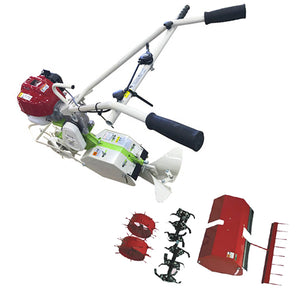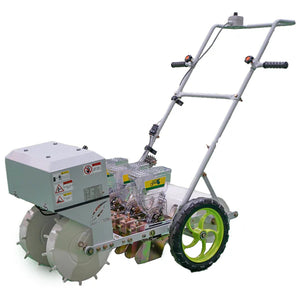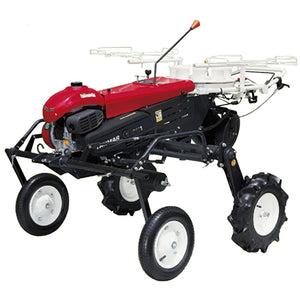Rice threshing is the work of separating paddy rice from the straws after harvesting.
The threshed paddy rice is usually dried in the rice dryer the same day.
Threshing with combine harvester

Threshing using a combine harvester.
The harvested paddy rice with straw is sent to the threshing section by a transport chain.

The illustration is the basic structure inside the combine harvester.
The area surrounded by red is the threshing section.
In the threshing section, there is a "threshing body" with many threshing teeth. This threshing body rotates, and the paddy rice is scraped off by the sides of the threshing teeth and threshed.

The photo above is a "foot-operated threshing machine" that has been used since the Meiji era (late 1800s) in Japan. The mechanism of the threshing body and threshing teeth is still applied to the modern combine harvesters.

Due to the rotation of the threshing body, the threshing teeth are moving from the back to the front while scraping off the paddy rice.

The threshed paddy rice passes through this receiving net and falls to the sorting section.
The threshed paddy rice is mixed with rice leaves and straw. In the sorting section, paddy rice is sorted by two methods: wind sorting and swinging.

By swinging the plate, rice and straw waste are separated.

The swinging action causes the small paddy rice to fall to the bottom. On the other hand, the straw waste remaining on the swinging plate is sucked by the suction fan and discharged to the outside of the machine.

Wind sorting is a method that utilizes the power of the wind. When the wind blows, if you drop a mixture of paddy rice and straw from a high place little by little, the heavy paddy rice will fall down, but the light straw and other wastes will be blown away by the sideways wind.
In the Meiji era, China introduced a wall insert that artificially created a wind and sorted it according to its weight, such as paddy rice and straw waste. This is a convenient device that applies the principle of wind selection. It is said that it was widely used by ordinary farmers during the era after. In modern times, when there is no wind, an agricultural fan or the like is used to create the wind.

Modern combine harvesters also use this wind selection mechanism. The fan creates the wind to sort. This fan is still called "Toumi" in this day.
The photo on the right above shows the wind of Toumi flying fine straw remanents. Straw waste is discharged to the outside of the machine. Light straw is blown away, but heavy paddy rice falls. The paddy rice from which straw has been removed in this way is sent to a grain tank or rice bag by a grain conveyor and stored.
Treatment of straw with combine harvester and harvesting of paddy rice

After threshing, the straw is sent to the straw processing section by the straw chain.

The straw is finely chopped by disc cutters and discharged in the rice fields. Straws are plowed into the soil when finishing rice fields at the end of the seasons and becomes fertilizer.
In addition, it may be just dropped without using disc cutters, or it may be dropped by being binded.

On the other hand, the paddy rice collected in the grain tank is discharged to a container by the unloader.

It may also be discharged into a rice bag. Depending on the combine harvester model, it may be stored directly in the rice bag.

The harvested rice is transported the same day and dried in a dryer.
In the old harvest, rice was harvested, dried in the sun, and then threshed, but now it is harvested and threshed at the same time with a combine harvester.
Moisture of raw rice immediately after harvesting is about 20 to 25%.
Raw rice begins to deteriorate after 5 hours at a grain temperature of 25 degree Celsius and after about 3 hours at 35 degree Celsius.
Therefore, it starts to dry within 5 hours after harvesting to protect the quality.
Dry until the water content becomes about 14.5 to 15%.
In addition, it becomes harder when it dries, and it is harder to break when it is hulled.





